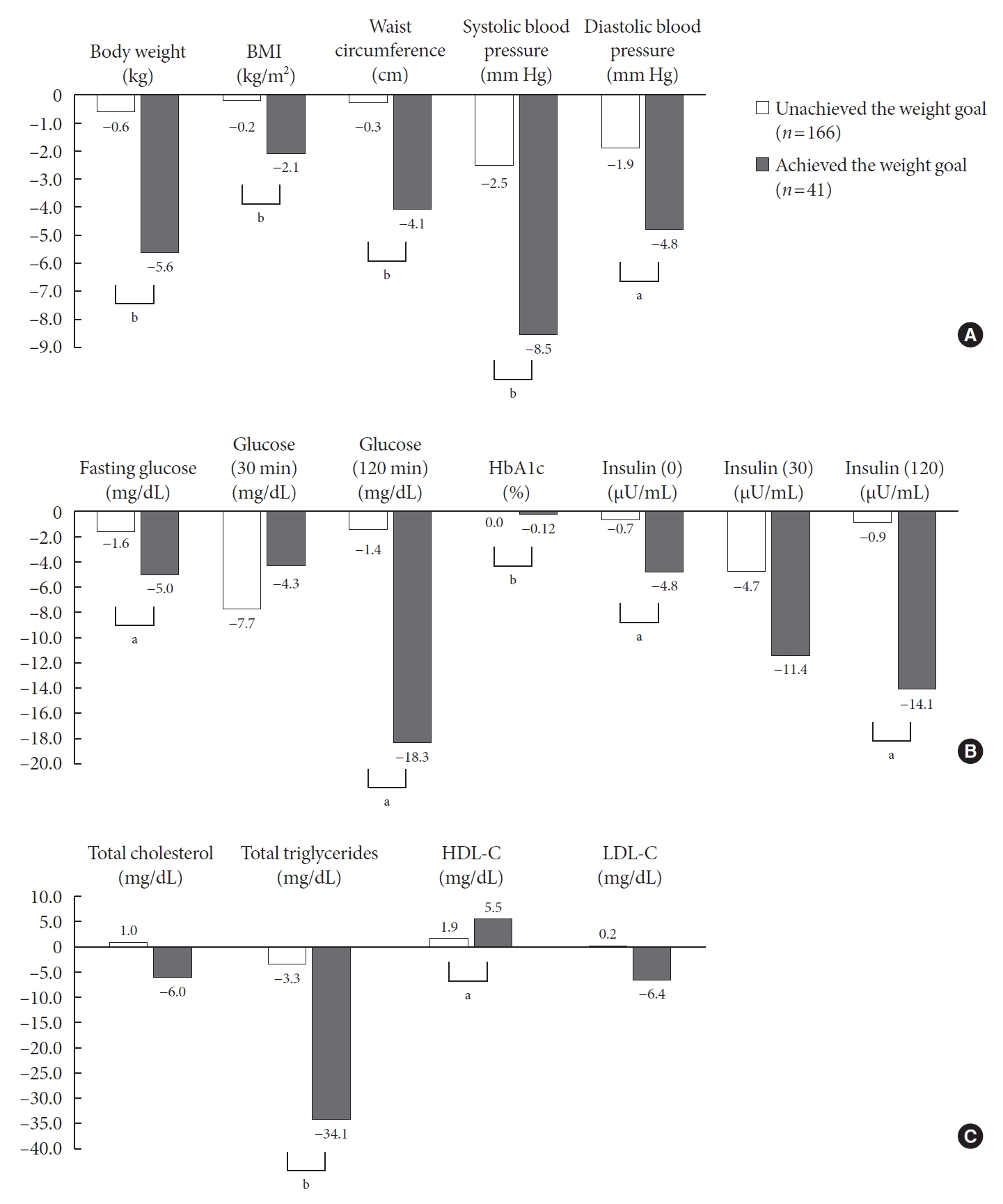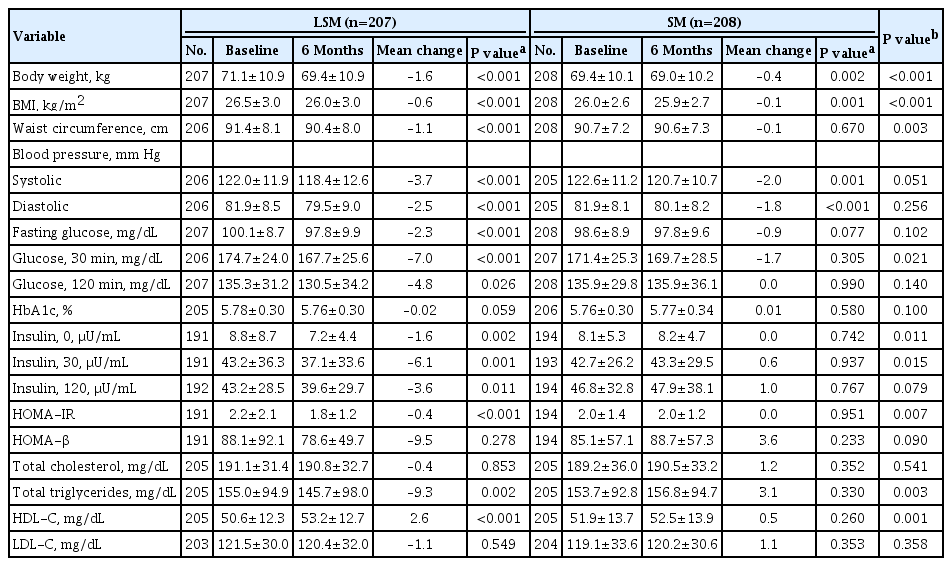Short-Term Effects of the Internet-Based Korea Diabetes Prevention Study: 6-Month Results of a Community-Based Randomized Controlled Trial
Article information
Abstract
The aims of this study were to determine the short-term effectiveness of an internet-based lifestyle modification (LSM) program in preventing the onset of type 2 diabetes mellitus (T2DM) in prediabetes patients in community settings. A total of 415 subjects who were diagnosed with prediabetes were randomly assigned to the LSM and standard management (SM) groups. After the 6-month intervention, the LSM group had a statistically significant reduction in body weight, body mass index compared to the SM group participants. In the LSM group, blood glucose levels were significantly decreased after intervention and the clinical improvement effect was evident in the group that achieved the target weight loss of 5% or more of the initial weight for 6 months. Internet-based 6-month-intensive LSM programs conducted by public health center personnel are an effective way to provide lifestyle intervention programs and encourage maintenance of healthy behaviors in subjects with a high risk of T2DM in community settings.
INTRODUCTION
Diabetes is a serious health problem worldwide and continues to increase [1,2]. Several randomized clinical trials (RCTs) have reported that the intensive lifestyle intervention (LSI) can significantly reduce the incidence of diabetes in prediabetes [3-5]. In recent decades, internet-based weight management and LSI programs that can increase the accessibility and effectiveness of healthcare have been developed, and several clinical trials have been conducted to evaluate the effects of weight loss on diabetes onset [6-9]. Unfortunately, there were no RCTs evaluating the effectiveness of diabetes prevention in Korea. To establish evidence for this, the national R&D project for the hospital-based [10] and community-based Korean Diabetes Prevention Study (KDPS) [11] has been in progress since 2016. The aim of this paper was to determine the short-term effectiveness of an internet-based lifestyle modification (LSM) program in the community-based Korean Diabetes Prevention Study (C-KDPS).
METHODS
The study design and protocol were described in detail in a preceding paper [11]. This study received ethical approval from the Institutional Review Board of St. Vincent’s (No. VC16MISI0003) and Seoul St. Mary’s Hospital (No. KC16EISI0234), the Catholic University of Korea. All of the participants provided written consent for participation.
Participants
Total 415 subjects were randomly assigned to the LSM and the standard management (SM) groups using a stratified blocked randomization strategy [11]. Six months after the core program, the subjects who completed the first follow-up numbered 144 in the LSM group and 142 in the SM group.
Measurements
We calculated body mass index (BMI) from body weight and height, which were measured by standard methods. Blood sampling for biochemical assays was drawn in the morning after a 10- to 12-hour overnight fast, and all subjects underwent a 75-g oral glucose tolerance test with glycosylated hemoglobin (HbA1c) level measurement. All laboratory parameters were evaluated in the central laboratory (Seegene Medical Foundation, Seoul, Korea).
Statistical analysis
We analyzed by intention-to-treat (ITT) as recommended in the consolidated standards of reporting trials (CONSORT) statement [12], and the baseline observation carried forward (BOCF) [13] method was used for the values of subjects who were not followed up. To compare the change within groups, we used the Wilcoxon signed rank test. Six-month changes in the outcomes compared between two groups using a repeated measures analysis of covariance (ANCOVA). In the LSM group, an analysis was also conducted to determine whether the clinical outcomes differed depending on whether the weight loss goal set at the start of the study was achieved. Statistical analyses were performed using SAS version 9.3 (SAS Institute Inc., Cary, NC, USA).
RESULTS
Changes in body composition and blood glucose levels
Baseline characteristics did not differ significantly between the LSM and SM groups. The mean age of the two groups at randomization was 52.6±7.5 and 53.5±7.4 years in the LSM and SM groups, respectively, with female participation rates of 55.6% and 52.4%, respectively.
After the 6-month intervention, LSM group participants had a statistically significant reduction in body weight and BMI compared to SM group participants: weight loss was –1.6 kg in the LSM group versus –0.4 kg in the SM group (P<0.001), the change in BMI was –0.6 kg/m2 in the LSM group versus –0.1 kg/m2 in the SM group (P<0.001). Although there was no difference between groups, fasting plasma glucose (FPG) and 2-hour plasma glucose (PG) showed statistically significant decreases after the intervention compared to before the intervention in the LSM group (Table 1).
Differences in clinical outcomes with or without the archiving of the weight loss goals after 6 months in LSM
One of the major goals of the C-KDPS is a minimum of 5% loss of initial body weight in 6 months and maintenance of this weight loss. Therefore, we analyzed the differences in clinical outcomes with or without achievement of the weight loss goals after 6 months among 207 patients in the LSM group (Fig. 1). After 6 months, 41 (19.8%) of 207 people achieved their weight loss goals, and 166 subjects (80.2%) did not. The positive improvement in anthropometric measures was greater in the group that achieved the weight loss goal. The changes in blood glucose (FPG: –5.0 mg/dL vs. –1.6 mg/dL, P=0.029; 2-hr PG: –18.3 mg/dL vs. –1.4 mg/dL, P=0.001; HbA1c: –0.12 vs. 0.00, P<0.001) were significantly lowed in the group that achieved the weight goal after 6 months.

Changes in clinical outcomes from baseline to 6 months in the lifestyle modification group, according to whether subjects achieved their target weight. (A) Mean changes in anthropometric measures and blood pressure, (B) mean changes in blood glucose and insulin level, (C) mean changes in lipid profiles. White bar represents the changes in clinical parameters in the unachieved the weight goal, while grey bar represents the change in clinical parameters in the achieved the weight goal group. Repeated measures analysis of covariance (ANCOVA) test was used for panels A, B, and C. We adjusted for age and sex. BMI, body mass index; HbA1c, glycosylated hemoglobin; HDL-C, high-density lipoprotein cholesterol; LDL-C, low-density lipoprotein cholesterol. aP<0.05, bP<0.001 for the difference between two groups.
DISCUSSION
In this study, we found that the application of an Internet-based Diabetes Prevention program (DPP) helped to improve clinical markers related to diabetes onset, such as FPG and homeostatic model assessment for insulin resistance (HOMAIR), in prediabetic subjects. As a result of comparing the effects according to whether the LSM group achieved the target weight, the clinical improvement was greater in the group achieving the target weight.
Of several studies on the short-term effect of a technology-driven DPP [14-16], only one RCT reported changes in FPG and HbA1c [15]. In Block’s study (mean age 55 years, mean BMI 31.1 kg/m2) [15], diabetes prevention and weight loss with a fully automated behavioral intervention for subjects with prediabetes yielded mean changes in FPG of –7.36 mg/dL in the intervention groups compared with –2.19 mg/dL in the control groups at 6 months (P<0.001). Compared with the Block’s study, our results showed a milder reduction in both FPG and HbA1c in the LSM group. The reason for this is because the FPG of our study was approximately 100 mg/dL at baseline, which was 10 mg/dL lower than that in Block’s study. The baseline FPG among participants was similar to that of subjects of the same age, as reported by the Korea National Health and Nutrition Examination Survey [17]. Our participants had prediabetes, but subjects with a very low risk of developing diabetes.
Previous technology-driven diabetes prevention studies [15,18,19] reported weight loss in the intervention group, ranging from –2.3 [19] to –6.7 kg [18], over a period of 3 to 6 months. These studies were conducted in prediabetic subjects with BMIs ranging from 31.1 to 38.7 kg/m2 in Western countries. In our study, subjects with a mean BMI of 26.3 kg/m2 were included in the study and losing more than 5% of their initial body weight during the 6 months of the study was recommended. The weight loss after 6 months showed a significant difference between two groups (P<0.001), but the degree of weight loss was less than that in previous studies. It was found that in the intervention group, the weight loss target achievement rate was approximately 20% for 6 months, and 2-hour PG, HbA1c, fasting insulin, and HOMA-IR were significantly improved in the group that archived the target weight compared to the group that did not achieve the target weight. Therefore, this result supports the hypothesis that there is a link between weight and risk factors for diabetes and cardiovascular disease [20].
The advantage of our research is that it is a well-designed RCT conducted in the community. In addition, the web system was used to effectively apply the DPP to high-risk people with diabetes, and public health manpower is in the people who manage the subjects. These findings could provide an important basis for the development of a model that can effectively disseminate diabetes information to the community in the future.
The limitations of this study are as follows. First, our study was short-term, so it could not assess effectiveness over the long-term, but we will report on the long-term effects in future studies. Second, the 6-month follow-up rate of subjects enrolled in the study was approximately 70%, slightly lower than the originally planned 75%. Although not presented in the study results, the analysis results showed that there was no characteristic difference depending on whether follow-up was performed in either the LSM group or the SM group, so we think the influence of selection bias will be insignificant. In addition, ITT analysis was conducted, and BOCF [13] was used for the values of subjects who were not followed up. This method is suggested by regulatory agencies when evaluating clinical trials because it seems to be more conservative.
In conclusion, the present study showed the short-term effectiveness of an internet-based Korean DPP in communities. Future studies will analyze the primary outcome of this study to investigate the effectiveness for prevention of diabetes in prediabetes subjects, and it will serve as a basis for suggesting strategies to effectively prevent diabetes in the community setting.
Notes
CONFLICTS OF INTEREST
No potential conflict of interest relevant to this article was reported.
AUTHOR CONTRIBUTIONS
Conception or design: J.H.L., K.H.Y., S.H.K.
Acquisition, analysis, or interpretation of data: J.H.L., S.Y.L., S.A.C., C.J.H., A.R.J., K.R.K., S.H.K.
Drafting the work or revising: J.H.L., K.H.Y., S.H.K.
Final approval of the manuscript: J.H.L., S.Y.L., S.A.C., C.J.H., A.R.J., K.R.K., K.H.Y., S.H.K.
FUNDING
This research was supported by a grant of the Korean Health Technology R&D Project through the Korea Health Industry Development Institute (KHIDI), funded by the Ministry of Health & Welfare, Republic of Korea (grant number: HC15-C3364).
Acknowledgements
The research team would like to thank the Korean Diabetes Association, and two healthcare centers of Chungju city and Paldal-Gu, Suwon city.


